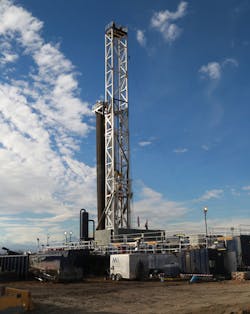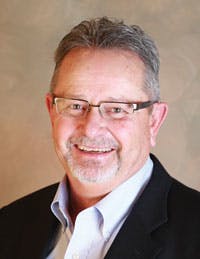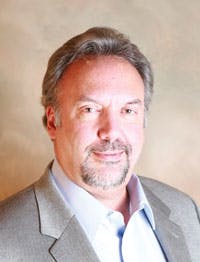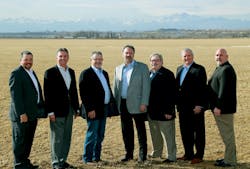Synergy setting the standard for operating efficiency
EDITOR'S NOTE: We recently talked to Ed Holloway and Bill Scaff, co-CEOs of Synergy Resources Corp., a Platteville, Colo.-based energy company with assets in the Denver-Julesburg Basin. Synergy was the fastest-growing company among the OGJ150 group of companies, ranked according to stockholders' equity, for the third quarter of 2013.
OIL & GAS FINANCIAL JOURNAL: Synergy has built a strategic position in one of the most productive plays in North America. How did you gain access to the play and are you continuing to grow your position?
EDWARD HOLLOWAY: Bill and I have spent our entire careers in the D-J Basin focused primarily on the Wattenberg Field. Over a 30-year period we have built three private companies and sold those assets to larger public companies.
WILLIAM SCAFF JR.: Synergy was formed in 2008 and went public through a reverse merger with Brishlin, a public operating company. Ed and I were brought in by the founders of Synergy to become the executive management team in the summer of 2008. We are using our 30 years of experience in the D-J Basin to strategically position the company in the heart of the play. One-third of the position has been established through organic leasing, which is continuing on a daily basis, and the remaining two-thirds of the position has been established through acquisitions.
OGFJ: Anadarko Petroleum has said it believes more than one billion barrels are technically recoverable from the D-J Basin. How is Synergy situated in the D-J to capture its share of those billion barrels?
HOLLOWAY: We have taken a calculated approach in expanding our leasehold and acquiring producing assets in the Wattenberg Field in areas that on a vertical basis have been shown to have a higher oil content and in areas that have some virgin rock in the field. Our local knowledge and reputation has enabled us to capture assets at a relatively competitive rate. Often, we have been given first look at leases because of our long history in the area. We own interests in more than 392,000 gross acres. In the Wattenberg Field, we operate and have production on a 25,200-net acre position and we have operational control on more than 24,700 net acres in the NE Wattenberg Extension Area, 160,000 net acres in Nebraska, and 61,000 net acres in eastern Colorado, thus becoming the public company with the highest concentration of assets in the D-J Basin. Our leasehold gives Synergy well over 1,000 potential horizontal drilling locations.
The Wattenberg is a low-risk development play which is all about operating efficiencies, something we excel at. Synergy has successfully completed 100% of its wells in the field. We are drilling and completing horizontal wells significantly under the original budget of $4.5 million per well. We estimate that our all-in cost for a standard horizontal well will range between $3.4 million and $3.8 million, depending on the number of frac stages and the lateral length of each.
OGFJ: Tell our readers about your drilling program. You have multiple benches to drill in the D-J Basin — Niobrara A, B, and C, and the Codell. Each has drilling and completion complexities. How do you explore, permit, drill, and produce each zone at its highest and best rate to generate your preferred rates of return?
SCAFF: We use best-in-class service providers like Ensign Drilling Company of North America and Halliburton. We are drilling our wells with the heel of the lateral in the bottom of a particular zone, and we orient the well to finish toe up. And we are drilling according to plan and not chasing the formation. We have reduced the distance between each frac stage and our goal is to average 24 to 26 stages per standard horizontal well of 4,500 to 4,900 feet. We plan to permit wells on a higher density basis per spacing unit going forward. We are also watching the improving results from the industry's longer lateral wells, and we plan to drill both mid-reach and extended-reach laterals in the future.
We see significant upside potential — multiple pay zones with horizontal wells targeting the Niobrara A, B, and C benches and the Codell formation. There is also potential for development of the Sussex, Shannon, Greenhorn and J Sand.
Synergy will invest $189 million in fiscal 2014 to drill 34 horizontal wells as operator. Pad-based drilling, as seen on the Union Pad, supports the company's production growth plans. The average drilling and completion costs using pad-based drilling is less than $3.6 million per well for Synergy.
All photos by Debbie Grillo, Eye Capture Photography
OGFJ: When you started Synergy, wasn't your business model to be a non-operated company? You later modified the model and became an operator. What are the advantages for Synergy as an operator? How much production and acreage do you now control?
HOLLOWAY: We prefer to operate our positions. We began participating in horizontals as a non-operator, but we have been operators of vertical wells for over 30 years. With our horizontal drilling program, we have partnered with companies gaining insight into the best-in-class processes for drilling and completing horizontal wells, simultaneously building a core area for efficiently operating large and concentrated position. We pride ourselves in being efficient operators and we have demonstrated our capability to reduce costs versus our competitors both on horizontal and vertical wells by 10% to 20%. We can achieve this by micro-managing each of our horizontal pad sites and by having a very low cost of overhead. We control about 75% of our acreage in the Wattenberg Field and even a higher percentage of our leases in the NE Extension Area.
One of the reasons we used non-operated wells in the beginning was to manage the risk and to identify opportunities for efficiencies that could be exploited later as an operator. This essentially shortened the learning curve for us.
OGFJ: I understand that key people in your organization have midstream experience. How will that help the company as you move forward in the development stage?
SCAFF: Craig Rasmuson, our chief operating officer, worked for DCP Midstream, our midstream partner. We work closely with DCP to ensure we have the gas hook-up ready before we finish completing our horizontal wells so we can begin producing as soon as we are done and begin the payback period. As we permit new pad sites for drilling, we are taking into account where DCP has the best infrastructure in place.
HOLLOWAY: Bill, by the way, has experience as the regional manager with Total Petroleum, which is now Suncor, the only local refiner. The key is the relationships that Bill and I have established and maintained over the past 30 years. This helps us understand the midstream constraints and negotiate favorable takeaway contracts.
OGFJ: Operators in the D-J Basin have long dealt with production transportation issues, including compression for natural gas, crude oil storage, and processing. What are midstream companies doing to increase their capacity in these areas as the basin's production continues to grow?
HOLLOWAY: DCP is in the middle of a massive capital expenditure program which goes through 2015 that will increase takeaway capacity in the Wattenberg Field by nearly four-fold compared to a few years ago. This enhanced processing capacity will lower line pressures in the system and allow the wells to produce more to their optimum potential. At this time, infrastructure is one of the key constraints on the growth of the entire field. As operators in the field moved to horizontal drilling, the legacy infrastructure needed to be updated. This is going on right now.
OGFJ: What are your daily production targets for 2014 and 2015? How will those plans be funded, and how will your staff meet the operating challenges?
SCAFF: We provided guidance that we expect our average daily production will range between 5,100 and 5,500 BOED in Fiscal 2104. We are currently working on fiscal 2015 and will provide guidance during a future earnings call. We believe that our current cash position, internally generated cash flow, and proceeds from our $6 warrants is sufficient to meet the $189 million in capital expenditures we have budgeted for fiscal 2014. We have already expanded our land department in anticipation of this growth, and we are adding to our operations staff to handle a two-rig drilling program.
HOLLOWAY: If we need to borrow, the interest rate on our revolver is 2.67%, which is very low. That, combined with the $53 million available on our $90 million barrowing base, allows us to be opportunistic on future development and acquisitions without putting a lot of strain on the balance sheet. We have built the company with the belief that returns and cash flow are the keys to future success.
OGFJ: When you look at your operated acreage position, you seem to be well situated with some of the best operators in the business. Your cash margins are greater than $42 per BOE. How are you able to outperform your competitors in the D-J? When will Synergy be in full-scale development mode?
HOLLOWAY: As we mentioned before, we have low G&A. We have the benefit of having operated in this field for over 30 years, and we strive hard to work with our royalty owners to get them to understand that we are partners, and in areas where they can help us save on costs, we all stand to benefit. Regarding full scale development, I would say that we entered that phase with the two-rig horizontal drilling program, and we will look to accelerate the development with additional rigs at the appropriate time.
SCAFF: We will only drill wells when guaranteed infrastructure is in place so that the payback period remains as short as possible. We use what we have learned from participation with other key operators to find efficiencies in our operated program. We are targeting a pay back of our invested capital in two years or less depending on commodity prices and costs.
OGFJ: How does Synergy's modest size factor in to competitively securing drilling rigs, pipe, frac stages, and other mission critical aspects that enable a company to compete economically in the D-J basin?
SCAFF: We have been operating in the Wattenberg Field using Ensign Drilling and Halliburton for decades, and we have no issues in securing rigs and services. There are many service providers in the Wattenberg field, and that competition tends to keep prices in check. We are continually looking at ways to save and cut costs, and our message to the service providers and vendors is basically — "When we work together on creating efficiencies, it allows us to drill more wells and increases the potential for future business." This creates a win/win situation for all parties.
COMPLETION OPERATIONS at the Renfroe Pad. As of publication of this issue, the company was on pace to perform more than 780 fracture stimulation stages, a new company record.
All photos by Debbie Grillo, Eye Capture Photography
OGFJ: Synergy operates approximately 20,000-plus net acres in the northern D-J basin. What are your plans for this area? Do you plan to add acreage?
SCAFF: The Wattenberg has multi-zone potential, so a company doesn't have to have a huge surface acreage position to capture a large resource. The company has rights to all depths across the acreage, and as a result, there are economic opportunities in those additional zones. Currently Synergy is drilling horizontal wells targeting the Niobrara A, B, and C benches and the Codell formation. There is also potential for development of the Sussex, Shannon, and Greenhorn down the road. Each additional economic zone essentially multiplies the company's acreage position.
OGFJ: I understand from your website that your Nebraska holdings also offer multi-stack potential. Can you tell our readers who else is operating there and if this is an operated opportunity for Synergy? What do you estimate is the gross ultimate potential there?
HOLLOWAY: There are several private companies drilling in Nebraska and one public company, Forestar out of Texas, and they are all having great success from what we have learned. This is an area that fits our criteria perfectly. First, we have long-term leases with an average of seven years remaining, which we obtained at $30 to $40 per acre and have a high net revenue interest of 85% or better. It is a multi-stacked play that works with vertical drilling just like the Wattenberg. Our view today is to let the other operators de-risk the play before we commit drilling capital. 3D seismic appears to be an important tool in the play, and you may see us put some capital into seismic in fiscal 2015 to delineate where the most prospective targets might be. We have nearly 160,000 net acres in Nebraska, and it could turn out to be as important to Synergy as our Wattenberg field asset, so it is an exciting option in our asset base.
OGFJ: Synergy management and board members own 16% of the total outstanding shares. Why is this important to you and to shareholders?
HOLLOWAY: We think it's important to align ourselves with all shareholders and to offer our employees a chance to participate in the growth of the company through equity ownership. Bill and I are committed to being good stewards of capital and not to stress the balance sheet with debt.
OGFJ: Your revenue mix is 86% liquids, yet you have a dry gas position in Eastern Colorado. Where would natural gas prices need to be for this asset to factor into your spending program?
SCAFF: Eastern Colorado gives us another option if gas prices improve. The area is well established and was drilled extensively decades ago, so there is no mystery out there. At $4.50/MCF, the play is economic. However, prices would need to be well above $5.00/MCF at the wellhead for the rate of return to compete with what we are enjoying in the Wattenberg. We have long-term leases in Eastern Colorado, so we can afford to be patient and wait.
OGFJ: Thanks very much for your time.
Synergy Resources Board of Directors from left to right: Bud Noffsinger III, Ray McElhaney, Ed Holloway, Bill Scaff, George Seward, Rick Wilber and Bill Conrad.
All photos by Debbie Grillo, Eye Capture Photography





